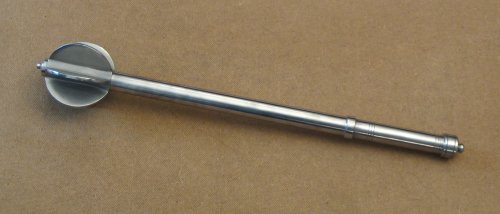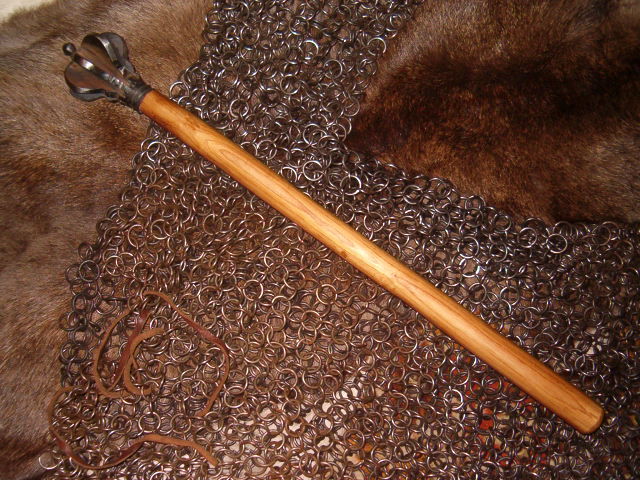| Author |
Message |
Aaron Morris

Location: pueblo,colorado Joined: 03 May 2009
Posts: 26
|
 Posted: Sat 19 Mar, 2011 9:16 am Post subject: semi circular flanges on maces Posted: Sat 19 Mar, 2011 9:16 am Post subject: semi circular flanges on maces |
 |
|
I've seen a few examples of maces with rounded flanges (such as one attached) was there a specific reason anyone knows of for rounded flanges, since from what I've seen most flanged maces seemed to be primarily triangular to help penetration in armor I suppose, so if anyone knows of a purpose for round vs triangular flanges it be appreciated, thanks
 Attachment: 17.26 KB Attachment: 17.26 KB

|
|
  |
 |
|
Ant Mercer
|
 Posted: Sat 19 Mar, 2011 10:52 am Post subject: Posted: Sat 19 Mar, 2011 10:52 am Post subject: |
 |
|
Hi,
I seem to remember Oakeshott writing something about the evolution of mace-heads in A Knight and his Weapons...
... hang on a sec...
'During the later fifteenth century maces became shapely weapons, in fact, from about 1440 to 1510 most weapons were not only very beautiful in form - more so than they had ever been before and would ever be again - but were magnificently made...'
<blah blah blah>
'...The mace of this period was a small weapon with a flanged head; the flanges were acutely pointed, in contrast to the flatter forms of the earlier types. This shape, however, seems to have had its disadvantages: instead of merely denting and crushing armour, its sharp flanges tended to punch through it, causing the mace to get completely stuck and so become wrenched from it's owner's hand. By the early sixteenth century the flanges of mace-heads became flatter again, but much more ornamental than before; they got bigger too.'
Hope this goes towards answering your question.
Thanks,
Ant
|
|
   |
 |
Aaron Morris

Location: pueblo,colorado Joined: 03 May 2009
Posts: 26
|
 Posted: Sat 19 Mar, 2011 5:04 pm Post subject: Posted: Sat 19 Mar, 2011 5:04 pm Post subject: |
 |
|
|
alright cool that makes sense thanks
|
|
  |
 |
|
Richard B. Price
|
 Posted: Sat 19 Mar, 2011 5:09 pm Post subject: Posted: Sat 19 Mar, 2011 5:09 pm Post subject: |
 |
|
I made mine pointy, if for no other reason than to puncture steel barrels and helpless tree stumps
 Attachment: 200.08 KB Attachment: 200.08 KB
[ Download ]
"We shall never know lasting peace until the last king has been strangled with the entrails of the last priest."
|
|
   |
 |
Nathan Robinson
myArmoury Admin


|
|
    |
 |
|
Henrik Zoltan Toth
|
 Posted: Mon 21 Mar, 2011 4:41 am Post subject: Posted: Mon 21 Mar, 2011 4:41 am Post subject: |
 |
|
I made my first one from file-pieces. Hungarian low-officiers/ or war-buzogány from around 1650, with 8 feathers.
Zoltán
 Attachment: 124.22 KB Attachment: 124.22 KB

|
|
  |
 |
Johan Gemvik

|
 Posted: Mon 21 Mar, 2011 4:52 am Post subject: Posted: Mon 21 Mar, 2011 4:52 am Post subject: |
 |
|
I think islamic maces were generally also rounded. I've read that islamic weapons and armour (i.e. plated maille) were exported in great numbers to eastern europe during medieval times. Some weapon ideas and types may well have emigrated the other way too.
This is good stuff!. Reminds me I have to make that viking mace.
"The Dwarf sees farther than the Giant when he has the giant's shoulder to mount on" -Coleridge
|
|
  |
 |
Aaron Morris

Location: pueblo,colorado Joined: 03 May 2009
Posts: 26
|
 Posted: Mon 21 Mar, 2011 9:28 pm Post subject: Posted: Mon 21 Mar, 2011 9:28 pm Post subject: |
 |
|
|
alright cool , by the way Richard how are the flanges attached on yours
|
|
  |
 |
|
Henrik Zoltan Toth
|
 Posted: Thu 24 Mar, 2011 11:04 am Post subject: Posted: Thu 24 Mar, 2011 11:04 am Post subject: |
 |
|
|
On the hungarian ones this was done with cupper or brass.
|
|
  |
 |
Romulus Stoica

Location: Hunedoara, Transylvania, Romania Joined: 26 Oct 2006
Posts: 124
|
 Posted: Thu 24 Mar, 2011 12:01 pm Post subject: Posted: Thu 24 Mar, 2011 12:01 pm Post subject: |
 |
|
|
All medieval (XII to XV century) maces in Transylvanian museums are bronze, cast in a single piece.
|
|
   |
 |
|
Richard B. Price
|
 Posted: Thu 28 Apr, 2011 2:09 pm Post subject: Posted: Thu 28 Apr, 2011 2:09 pm Post subject: |
 |
|
hey Aaron, the flanges are first notched to fit together at 90 degree angles (2 plates) then a steel sleeve was fitted over them, again notched to accommodate the intersecting plates. There are 2 threaded fittings, one top one bottom that are tightened then welded in place. the whole shebang weighs about 14 lbs. and is about 40 inches tall, about the height of my little guys.
"We shall never know lasting peace until the last king has been strangled with the entrails of the last priest."
|
|
   |
 |
|
|

